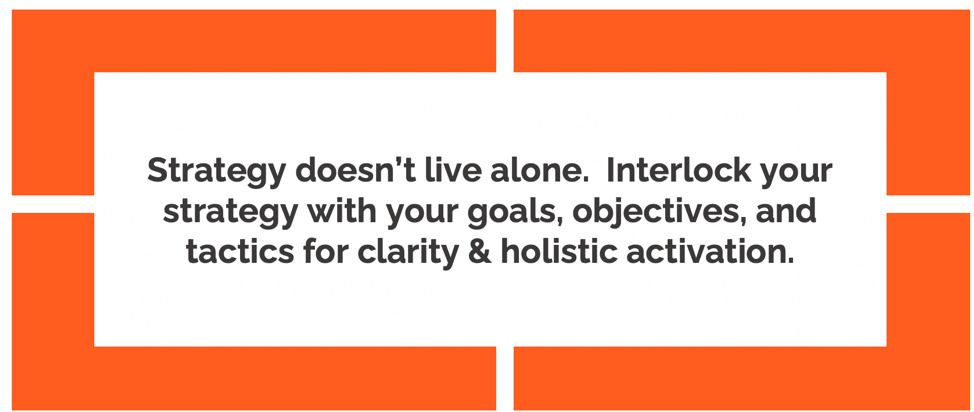GOST Framework: Goals, Objectives, Strategies, and Tactics Explained with an Amazon Example
By Adam Fischer • May 16, 2022

Do you believe in GOSTs?
No, we’re not talking about the sheet-wearing phantoms that Bill Murray blasts with his proton pack. GOST stands for Goals, Objective, Strategies, and Tactics; it’s a critical framework for strategic planning.
Have you ever worked in a job where it felt like people were really busy but nothing seemed to get finished? Or perhaps information was never translated across departments—or even from person to person?
Chances are one or more parts of GOST weren’t being communicated properly— or didn’t exist at all. The root cause of many business challenges is the lack of a strategic plan, clear visibility to that plan, and murkiness for how everyone fits in and is accountable to achieving goals.
Is the GOST model better than OGSM?
You’ve likely come across a similar acronym like OGSM (Objectives, Goals, Strategies, and Measures). Although very similar, what makes the GOST model superior to OGSM is that GOST explicitly has an S and T broken out, leading to clearer strategies. This elucidate how strategies and tactics are different yet connected, helping you avoid the pitfall of tactics with no real strategy behind them.
How to define goals, objectives, strategies and tactics?

One challenging with terms like goals, objectives, strategies, and tactics is that they’re often used interchangeably. Or, just as puzzlingly, they’re sometimes used to mean different things by different people.
Here’s our guide to GOSTs—a definition of each term that we’ll be using consistently throughout this article and on StrategyKiln.com.
We’ll be using a similar definition of goals and objectives as our friends over at HubSpot, as depicted in this image:

Goals
We start by defining goals vs. objectives. Goals are the desired results that you want to achieve at a high level. They are qualitative, long-term and help guide your overall direction. For example, a hospital’s goal might be to be the first choice pediatric care center in the region —a big, broad, long-term goal that can help guide that company’s choices and actions.
Objectives
An objective is not the same as a goal. Objectives are quantitative, specific, measurable outcomes that will help you achieve a goal. Objectives often include numerical targets such as revenue, sales, and market share. Sticking with our hospital example, a possible objective could be to increase patient satisfaction by 20% within the next 18 months. Often, you’ll have several objectives underneath an overarching goal.
Strategy
A strategy is a plan of action for how you’ll achieve your long-term goals. Strategies typically aren’t tangible, which may be why people often struggle to define the term. Strategy isn’t targets or numbers or concrete actions. It’s your choice for where to focus to drive differentiation or lower cost, or both, and how you will compete in the market.
How can I tell if something is a strategy?
Strategy must be what differentiates you from the competition. A surprising litmus test to tell if you have a “real” strategy is asking – “could I say NO to doing this?”
For example, a hospital can’t say that one of their strategies is patient safety because it’s a given that patient safety is every hospital’s concern (let’s hope, anyway). Your strategy cannot be what everyone else is already doing well, unless you somehow deliver incremental customer value. A hospital could say that one of its strategies is to improve the patient experience. They don’t have to do it, but it’s something that could set them apart from other hospitals.
Tactics
Tactics are the specific, tangible actions that help you achieve your strategy. If your strategy is improving patient experience, for example, your tactics might include sending patients a survey after every visit, improving hospital food, or better training for front-line staff.
For a deeper examination of strategies and tactics – check out this article dedicated to the topic.
Ever seen a GOST? Applying the GOST Framework with an Amazon Example
This holistic example should pull everything we’ve learned together and put it in context.
You can see from the diagram below that the GOST framework exists at different levels, with each level supporting the ones above it. You probably have an overarching goal at the corporate level that guides the entire company, then below that, you have a GOST framework for business units, and below that, you have GOSTs at the program level, for marketing, IT, operations, and so forth.

Corporate Level
At the corporate level, naturally, your GOST is going to be broad. In the case of an enormous company like Amazon, goals, such as “deliver more quality products to our customers faster than ever” are likely to be very big, with high level objectives such as, “Increase revenue by 30% year over year.”
Similarly, your strategy, which might be to “create omnichannel experiences across key growth industries” is quite broad, and the tactics that you’ll use to achieve that strategy, such as acquiring Whole Foods, acquiring Pillpack (which has since become Amazon Pharmacy), and expanding the AMZN Locker network, are big steps.
Business Unit Level
Now, these corporate strategies start to “cascade” down, informing GOSTs at the business unit level. Looking solely at the example of Whole Foods, the goal at the business unit level may be to leverage it into a leader in grocery delivery with an objective of increasing grocery market share from 2.5% at acquisition to 3.5% by 2021—a very specific, measurable outcome.
The strategies at this stage might include centralizing purchasing, adding Prime to Whole Foods brick and mortar stores, and driving micro visits with AMZN Lockers. Amazon doesn’t have to do these things to be a retailer, but these strategies are what differentiate it from other companies.
Tactics, of course, are specific steps that help achieve this strategy. At this level, they might include rationalizing vendors for economies of scale, creating in-store salience, and installing AMZN Lockers in Whole Foods stores.
Program Level
Now we cascade down to the program level—in this case, marketing, but IT, Operations, and many other departments will all have their own GOSTs that will support the business unit’s goals. Marketing’s goal is to introduce current customers to Whole Foods, and its objective is to increase new Whole Foods customers by 8% in 2021 while increasing micro visits by 10%.
Its strategies for accomplishing this might include driving awareness of Prime and AMZN Lockers in Whole Foods, while the tactics that support those strategies could include advertising and email campaigns.
Now you can say you’ve seen a GOST! Are your GOSTs clear and transparent—or shrouded in mystery? We encourage you to do a little GOST hunting in your own place of work.
Thank you for accepting all the puns from this article.
You can download the slides and GOST template for the Amazon example here.
If you have any questions or would like to share an example from your own experience...
Adam Fischer is a marketer with 10+ years of experience in brand management and digital marketing. He’s challenged conventional assumptions and taken bold moves to drive growth for small businesses like Dogeared Jewelry to multi-billion-dollar companies like CVS Health and Nature Made Vitamins. He leverages his B.S. in Philosophy from Northeastern University to ask questions that get to the heart of business issues, while his MBA in Marketing from the Thunderbird School of Global Management at ASU translates management philosophy into real strategic growth.
There is also a video that accompanies this post...
About this Author:
Adam Fischer is a marketer with over ten years of experience in brand management and digital marketing. He’s challenged assumptions and taken bold moves to drive growth in roles at small businesses like Dogeared Jewelry and multi-billion-dollar companies like Nature Made Vitamins and CVS Health. His B.S. in philosophy from Northeastern University helps him ask questions that get to the heart of business issues. His M.B.A. in marketing from the Thunderbird School of Global Management at ASU helps him thinking strategically about driving brands and growth.
Insights to fuel your marketing business
Sign up to get industry insights, trends, and more in your inbox.
Contact Us
We will get back to you as soon as possible.
Please try again later.
Latest Posts








